#museum from home
Artifact Road Trip - Massachusetts

Barns North Franklin, Mass.
By Lester Burbank Bridaham. This print was created for the Massachusetts Art Project, Federal Art Project, Works Progress Administration.
Find out more about this #ArtifactRoadTrip engraving on our Digital Artifact Collection: https://fdr.artifacts.archives.gov/objects/11504
Follow along each week as we feature a different artifact in our Museum Collection from each of the United States.

Artifact Road Trip - Maryland
 ALT
ALTA partial two-dollar bill issued by the Assembly of Maryland at Annapolis on March 5, 1770. It is payable in London at a rate of four shillings and sixpence (4s6d) sterling per dollar or equivalent in gold or silver. At the bottom of the bill are the original ink signatures of John Clapham and Robert Couden.
Find out more about this #ArtifactRoadTrip currency on our Digital Artifact Collection: https://fdr.artifacts.archives.gov/objects/10823
Follow along each week as we feature a different artifact in our Museum Collection from each of the United States.

Artifact Road Trip - Maine
 ALT
ALTA painting of the destroyer, USS ANDERSON, on patrol in Tenants Harbor, St. George, Maine, by Edwin Whitman. Commissioned in May 1939, the USS ANDERSON (DD-411), a Sims-class U.S. Navy destroyer, was named for Rear Admiral Edwin Alexander Anderson, Jr. The ship served in both the Atlantic and Pacific during WWII before being decommissioned in August 1946.
Find out more about this #ArtifactRoadTrip painting on our Digital Artifact Collection: https://fdr.artifacts.archives.gov/objects/29540
Follow along each week as we feature a different artifact in our Museum Collection from each of the United States.

 ALT
ALTOn this day May 15, 1942, The Women’s Army Auxiliary Corps (WAAC) Act was passed. During World War II, over 150,000 served, with jobs ranging from telephone, radio, and teletype operator to cryptographer, medical technician, sheet metal worker, and aircraft mechanic.
Learn more about this poster on our Digital Artifact Collection: https://fdr.artifacts.archives.gov/objects/15013
Artifact Road Trip - Louisiana
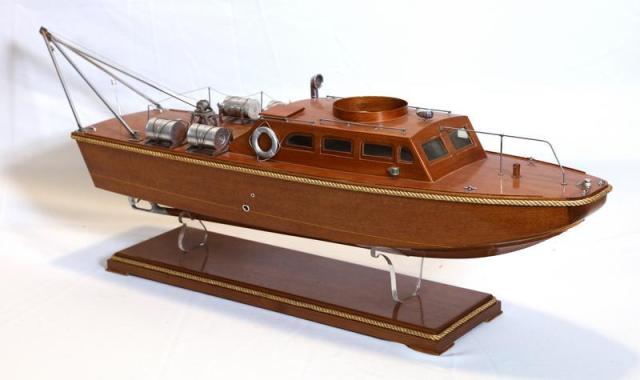 ALT
ALTA scale model of a fully equipped Patrol Torpedo (PT) boat. These boats were manufactured in large numbers during World War II by Higgins Industries of Louisiana. In October 1942, FDR visited a New Orleans factory operated by Higgins Industries. Company founder and president, Andrew Jackson Higgins, later gave Roosevelt this model of a Higgins PT boat on October 6, 1943.
Find out more about this #ArtifactRoadTrip model on our Digital Artifact Collection: https://fdr.artifacts.archives.gov/objects/2711
Follow along each week as we feature a different artifact in our Museum Collection from each of the United States.

“Mapping the New Deal”:
A Conversation with Richard Walker
Live, virtual program
Date: Wednesday, May 11, 2022, EDT
Time: 2:00 p.m. EDT
Link:https://youtu.be/KfULhsnpqtI
On Wednesday, May 11, 2022, at 2:00 p.m. EDT, the Roosevelt Library will present “Mapping the New Deal”: A Conversation with Richard Walker. FDR Library Acting Director William Harris will lead the discussion with Richard Walker, the Director of the Living New Deal Project. This live, virtual event will be streamed to the Library’s official YouTube, Facebook and Twitter accounts. Q&A in the comments/chat following the presentation.
The mission of the Living New Deal is three-fold: research, presentation and education. It begins with the historical work of uncovering the immense riches of New Deal public works. That research is then made available to all through digital mapping (livingnewdeal.org/map) and a website that serves as a clearinghouse for information on the New Deal. And, finally, the information gained from their work is disseminated as widely as possible through newsletters, social media, written media, interviews, lectures and other public events. For information visitlivingnewdeal.org.
Artifact Road Trip - Kentucky
 ALT
ALTDuring his far-flung wartime inspection tours, President Roosevelt often received models and other gifts from workers and staff in defense factories and military facilities. During the President’s April 30, 1943 inspection tour of Kentucky’s Fort Knox, Master Sergeant Ivan H. Howitz, gave FDR this model tank— a visual aid used at the base’s Armored Force School.
Find out more about this #ArtifactRoadTrip model on our Digital Artifact Collection: https://fdr.artifacts.archives.gov/objects/2546
Follow along each week as we feature a different artifact in our Museum Collection from each of the United States.

Artifact Road Trip - Kansas
 ALT
ALTThis painting depicting the mission of the National Youth Administration (NYA) was created in 1936 by NYA artist Alden Krider for an exhibit at the Kansas State Fair. The NYA (1935-1943) was a New Deal agency that aided young adults (ages 16 to 25) during the Great Depression. It provided vocational training and work-study assistance for high school, college, and graduate students.
Find out more about this #ArtifactRoadTrip painting on our Digital Artifact Collection: https://fdr.artifacts.archives.gov/objects/29779
Follow along each week as we feature a different artifact in our Museum Collection from each of the United States.

Artifact Road Trip - Iowa
 ALT
ALTFamily Quilting
This painting by Dorothea Tomlinson Marquis of Des Moines, Iowa, was created for the Treasury Department’s Public Works of Art Project (PWAP). It was displayed at the Corcoran Gallery from April 24-May 20, 1934.
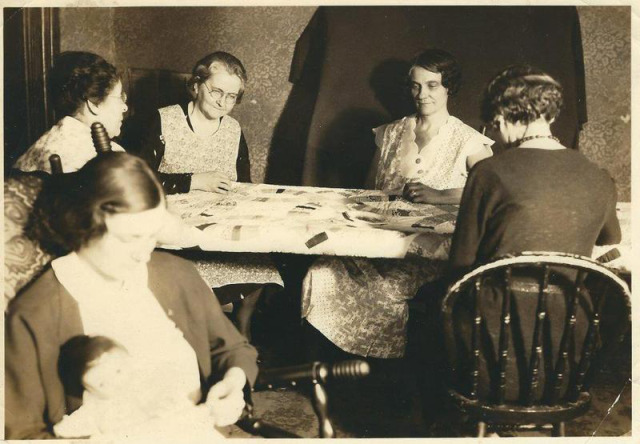 ALT
ALTPhotograph of the women posing for the Family Quilting painting by Dorothea Tomlinson. Image courtesy of the Franklin D. Roosevelt Presidential Library and Museum.
Find out more about this #ArtifactRoadTrip carving on our Digital Artifact Collection: https://fdr.artifacts.archives.gov/objects/8367
Follow along each week as we feature a different artifact in our Museum Collection from each of the United States.

Artifact Road Trip - Indiana


This carving was sent to Franklin D. Roosevelt in 1937 by the maker, Henry Weber of Oakville, Indiana. The white oak tree, from which the wood for the piece was taken, stood beside the trail leading from Abraham Lincoln’s cabin to the cemetery - and near the grave - of Lincoln’s mother, Nancy Hanks Lincoln, in Spencer County, Indiana. When the tree died in 1933, it was estimated to be 350 years old. The stump was shipped to Weber by his son, Horace S. Weber, a member of the Civilian Conservation Corps (CCC).
Find out more about this #ArtifactRoadTrip carving on our Digital Artifact Collection: https://fdr.artifacts.archives.gov/objects/627
Follow along each week as we feature a different artifact in our Museum Collection from each of the United States.

Artifact Road Trip - Michigan
 ALT
ALTThis statuette of a clipped poodle by Detroit artist Walter Edward Speck was made for the Michigan Art Project, Federal Art Project, Works Progress Administration.
Find out more about this #ArtifactRoadTrip sculpture on our Digital Artifact Collection: https://fdr.artifacts.archives.gov/objects/29357
Follow along each week as we feature a different artifact in our Museum Collection from each of the United States.

#AtHomeWithTheRoosevelts Conversations: Presidential Transitions
At Home with the Roosevelt Live - Encore Presentation:
A conversation between the former Franklin D. Roosevelt Library Director Paul Sparrow and the Harry S. Truman Library Director Kurt Graham on the April 12, 1945 presidential transition between the Roosevelt and Truman administrations.
REMEMBERING FDR
FDR’s death shocked the nation. Millions of American never forgot where they were and what they felt when they learned the news. Many reflected on how deeply his presidency had impacted their lives.
In 2005, the Franklin D. Roosevelt Presidential Library and Museum asked a group of Americans to talk about their memories of FDR’s death and reflect on his legacy. This program features excerpts from their recorded remarks.
This film, “Remembering FDR,” is also featured in the current exhibition “FDR’s Final Campaign” open now.
To keep updated on our At Home with the Roosevelts programs, subscribe bi-weekly E-Newsletter - https://lp.constantcontactpages.com/su/mwZHCz3/athomepage
FDR’s Last Days
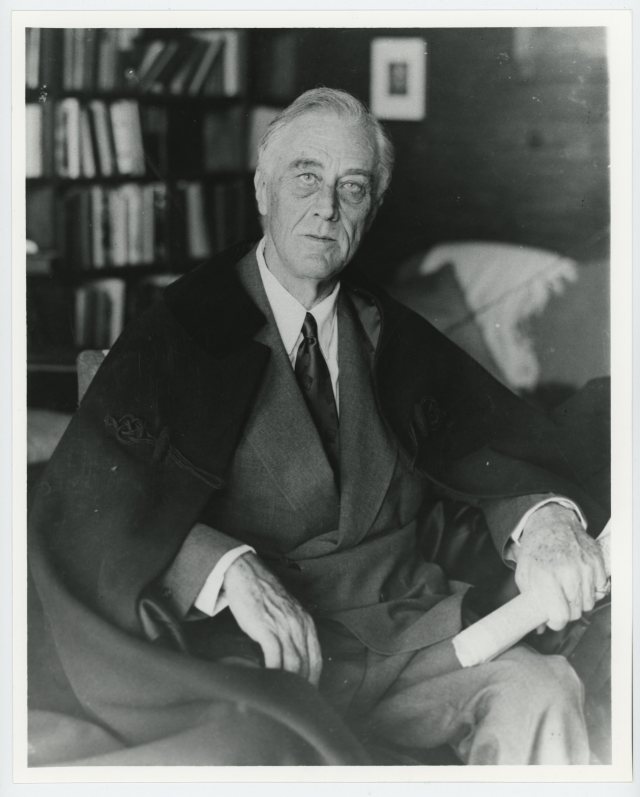 ALT
ALT ALT
ALTFDR’s last days were spent quietly at Warm Springs. The President sat for a portrait by artist Elizabeth Shoumatoff and conversed casually with his guests. On April 10 and 11, Shoumatoff’s assistant made a series of photographs of the President to assist her with her painting. They last images ever shot of him.
On April 10, FDR and Lucy Rutherfurd took a leisurely drive to Dowdell’s Knob, a rocky outcrop that offered a broad view of the surrounding countryside. Roosevelt had visited it many times during the difficult early years of his struggle with polio. It remained a favorite place to sit and reflect.
International issues still forced their way into the secluded world of the Little White House. Soviet actions in Eastern Europe threatened to divide the Allies just as victory was in sight in Europe. Seeking to maintain the alliance and ensure the success of the UN conference in San Francisco, FDR worked to smooth the waters. “I would minimize the Soviet problem as much as possible,” he wrote to Winston Churchill on the morning of April 11, “We must be firm, however, and our course thus far is correct.“ Later that dictated a speech he was to make on April 13. That evening, he dined with his Treasury Secretary Henry Morgenthau, Jr. Morgenthau was shocked by his old friend’s haggard appearance. Before he departed that night, FDR told him about his upcoming trip to the UN conference. He would appear there in his wheelchair, he told Morgenthau.
—
 ALT
ALT ALT
ALT ALT
ALTThese five photographs, shot on April 10-11, 1945, are the last images of President Roosevelt ever taken. They reveal the dire state of his health. The photographs were made by Nicholas Robbins, an assistant to artist Elizabeth Shoumatoff. Shoumatoff came to Warm Springs in April to paint a portrait of the President. She instructed Robbins take these photos to help her complete the portrait at her studio.
The three photographs of FDR outside his Warm Springs cottage were shot on April 10. The other two shots—taken inside the cottage—were made on April 11.
See these photographs and more in our current exhibition "FDR’s Final Campaign”.
Artifact Road Trip - Illinois
 ALT
ALT#ArtifactRoadTrip brings us to Illinois this week. “Snowy Days, Chicago” by Ceil Rosenberg is an oil painting that was created for the Treasury Department’s Public Works of Art Project (PWAP) in 1934.
Find out more about this painting on our Digital Artifact Collection: https://fdr.artifacts.archives.gov/objects/8376
Follow along each week as we feature a different artifact in our Museum Collection from each of the United States.

Artifact Road Trip - Idaho

In 1954, Eleanor Roosevelt traveled to the Northwest on behalf of the American Association for the United Nations in the hope of getting better organization in the states of Montana, Idaho and Wyoming. Mrs. Roosevelt received this commemorative trophy at an event in Pocatello, Idaho on September 30, 1954. She mentions the day’s events in her October 4, 1954 “My Day” column.
Find out more about this #ArtifactRoadTrip trophy on our Digital Artifact Collection: https://fdr.artifacts.archives.gov/objects/6937
Follow along each week as we feature a different artifact in our Museum Collection from each of the United States.

WARM SPRINGS, APRIL 1945
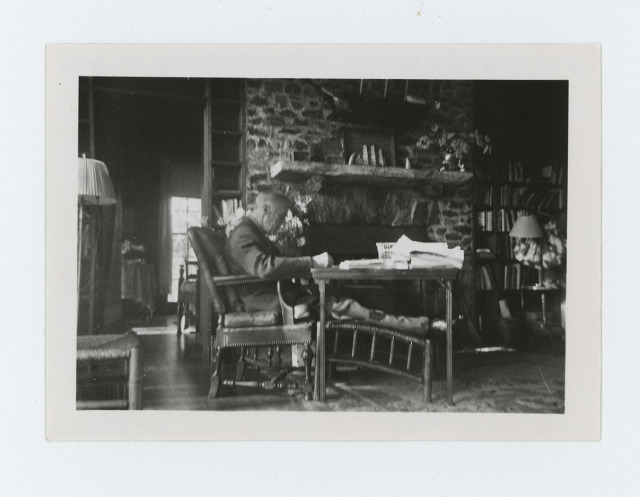 ALT
ALTPresident Roosevelt spent most of March at the White House and his Park estate. During these weeks he laid plans for the April conference Francisco that would draft a charter for the United Nations organization President took particular care to assemble a bipartisan U.S. delegation conference. These efforts were complicated by growing concerns about Soviet behavior in Eastern Europe, where Stalin was ignoring agreements at Yalta. Winston Churchill pushed Roosevelt to take a more confrontational approach with Stalin, but FDR counseled patience. He did not want to jeopardize Soviet participation in the United Nations, believing it offered the best hope for curbing Stalin’s bad behavior.
On March 29, a weary President departed Washington for a vacation in Warm Springs, Georgia. Eleanor Roosevelt and his daughter, Anna, remained in Washington. Both hoped FDR would rest and recover his strength at the “Little White House,” where he had often done so in the past. Roosevelt cousins Laura Delano and Margaret Suckley and his cardiologist, Dr. Harold Bruenn, accompanied him to Georgia. On April 9, they would be joined by another visitor-Lucy Mercer Rutherfurd.
At Warm Springs, FDR enjoyed the warm early Spring weather. Each day the President reviewed and signed papers. But there was ample time for car rides, his stamp collection, quiet meals, and rest. Roosevelt also began planning his trip to attend the opening of the UN conference on April 25.
 ALT
ALTSee these photos and more from FDR’s final days in our current exhibition, “FDR’s Final Campaign.”
Artifact Road Trip - Hawaii
 ALT
ALTThis model was presented to President Roosevelt by Troop 13 of the Boy Scouts of America in Honolulu, Hawaii. It was delivered to the White House by scouts Richard Noda and Hiroshi Daifuku. Roosevelt included the model in the inaugural display in the Naval Exhibition Room of the Roosevelt Library.
Find out more about this #ArtifactRoadTrip model on our Digital Artifact Collection: https://fdr.artifacts.archives.gov/objects/627
Follow along each week as we feature a different artifact in our Museum Collection from each of the United States.

National Quilting Day

Family Quilting by Dorothea Tomlinson Marquis.
This painting was created for the Treasury Department’s Public Works of Art Project (PWAP).
See some of the quilts in our collection on our Digital Artifact Collection: https://fdr.artifacts.archives.gov/search/quilt
FDR AND MARGARET SUCKLEY
Understanding Franklin Roosevelt’s inner motives and true intentions is a difficult task. The President did not keep a diary and rarely revealed his private thoughts to anyone. Margaret “Daisy” Suckley, a distant cousin, was a rare exception. To her, he confided some of his most private thoughts.

NPx 73-113:36: Cruise on USS Potomac, FDR with Margaret Suckley, March 18, 1939.
Suckley lived near Hyde Park and grew friendly with FDR during the 1920s. During the mid-1930s their friendship deepened and she became a frequent visitor at Springwood and the White House. Quiet, unassuming, and discreet, Daisy provided FDR with companionship and relaxing conversation that eased the burdens of the presidency. Roosevelt felt free to talk with her about his illness, possible retirement, and hopes for the future—including the United Nations organization.
Suckley kept an extensive diary that remained hidden until after her death in 1991. It offers rare insights into FDR’s thoughts—especially during the often lonely months of his final year. Daisy was aware of his frail health and doubts about running for a fourth term. In her May 22, 1944, diary entry, she carefully recorded his uncertain response when she asked if he’d decided on a running mate: “I haven’t even decided if I will run myself,” he admitted. “If I know I am not going to be able to carry on for another four years, it wouldn’t be fair to the American people to run for another term.”
Learn more about FDR and Daisy and see pages from her diary in our current exhibition FDR’s Final Campaign.
Artifact Road Trip - Georgia
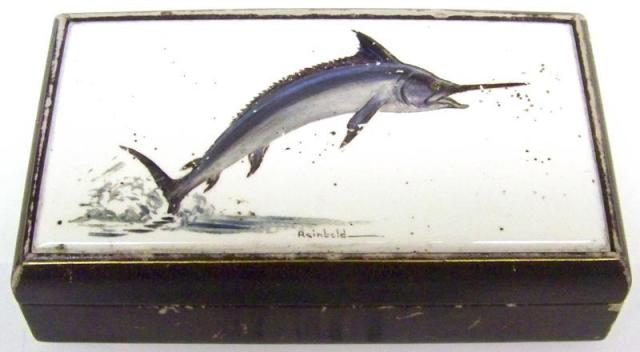 ALT
ALTThis box was sent to President Roosevelt by J. E. Ankus on June 23, 1941. Ankus was the parent of a polio patient admitted to the Warm Springs, Georgia, polio rehabilitation center established by FDR.
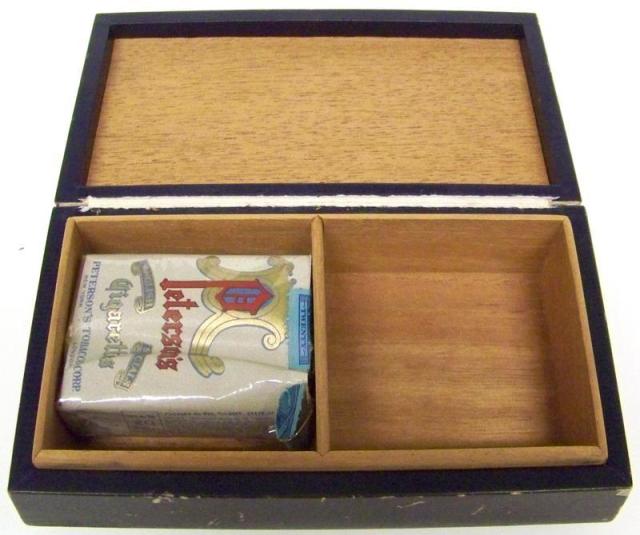 ALT
ALTFind out more about this #ArtifactRoadTrip cigarette box on our Digital Artifact Collection: https://fdr.artifacts.archives.gov/objects/29709
Follow along each week as we feature a different artifact in our Museum Collection from each of the United States.

